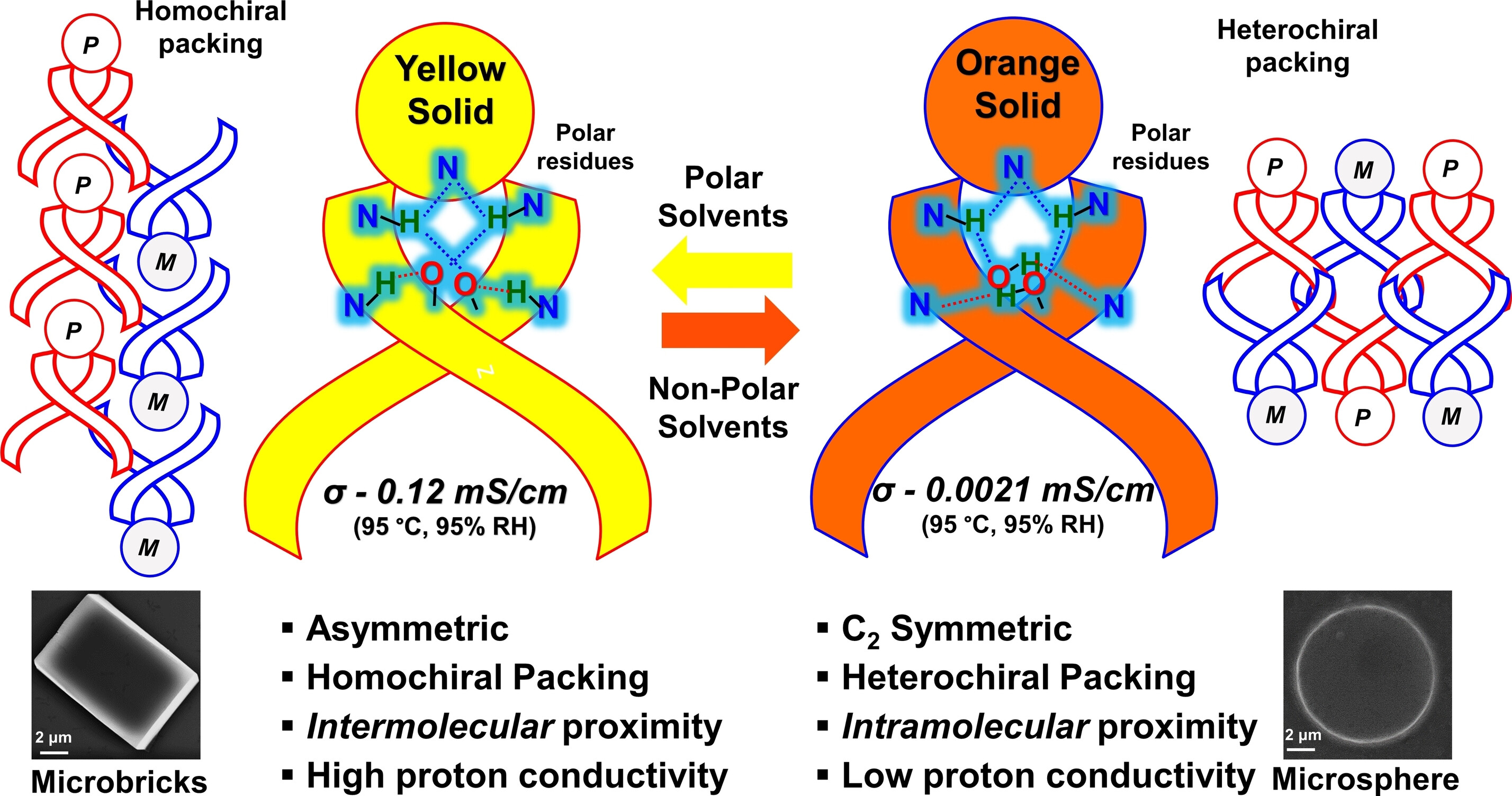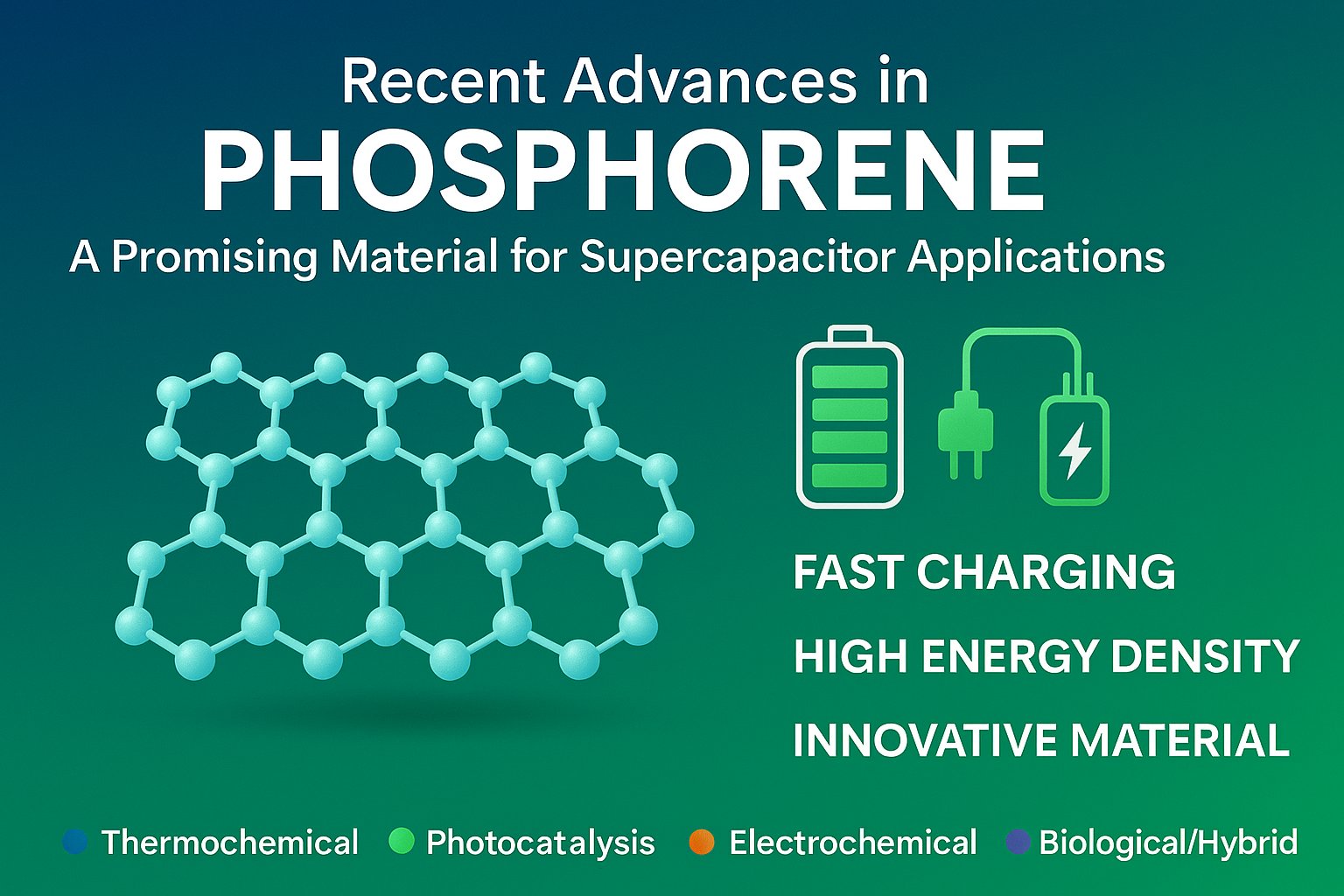Scientists from the Indian Institute of Science Education and Research (IISER) Bhopal have designed an uncharged ambipolar helical scaffold that achieves efficient solid-state proton conduction inspired by helical biomolecules such as DNA and gramicidin A. The team aimed to design a minimalistic organic scaffold that could achieve similar functional outcomes of high proton conduction while being synthetically accessible to allow scalability.
The research team designed an ambipolar helical scaffold derived from pyridine-2,6-dicarboxamide (PDC) that exhibits high solid-state proton conductivity despite lacking charged residues. The dense network of strong intramolecular hydrogen bonding stabilizes the helical conformation of the scaffold, in which the polar proton-conducting residues are organized along the inner face, while the nonpolar aromatic residues are present on the outer face. The ambipolar nature of the helices facilitates their self-assembly and proton transport through them.
Two different solid forms of the scaffold were isolated, which contain the molecules arranged in a stereodivergent manner, and the influence of these molecular features and packing patterns on proton conductivity was studied. The conductivities of the yellow and orange solids were determined to be 7.02×10^2 mS cm^-1 at room temperature and 1.85×10^4 ms cm^-1, respectively.
The yellow solid exhibited more efficient proton conduction, with conductivities reaching the milliSiemens/cm range. This was facilitated by the closer intermolecular proximity and relatively weaker intramolecular H-bonding in this form which significantly reduces the activation energy for proton conduction relative to the orange solid.
The researchers believe this study will competitively place such bioinspired uncharged organic scaffolds as capable solid-state proton conductors. The concepts presented here will likely expand the portfolio of synthetically accessible and structurally simple scaffolds with promising material performances. This research has been published in the journal Chemistry – A European Journal.
Bioinspired Design of an Uncharged Ambipolar Helical Scaffold To Achieve Efficient Solid-State Proton Conduction
Aggarwal; Pradip; Gaikwad; Dahat; Swapnendu; Ghosh; Mehra; Paul; Talukder; Srivastava
Full-text link: https://doi.org/10.1002/chem.202300019
What this paper is about
- Often, a conspicuous spatial organization of the polar and the nonpolar residues are observed in these biomolecules to impart the functional characteristics of efficient ion/ proton transport.
- Taking cues from the helical biomolecules such as DNA and gramicidin A, the researcher aimed to design minimalistic organic scaffolds that achieve similar functional outcomes of high proton conduction while being synthetically accessible to allow scalability.
- In this article, the researcher reports the rational design of ambipolar helical scaffolds derived from PDC for efficient proton conduction, isolating two different solid forms containing the molecules arranged stereo-divergent molecules and the influence of these molecular features and packing patterns on the proton conductivity.
What you can learn
- In conclusion, researchers have designed a gramicidin A-inspired helical scaffold, 1, derived from pyridine-2,6-dicarboxamide, that exhibits high solid-state proton conductivity despite lacking charged residues.
- In contrast, nonpolar solvents such as CHCl, DCM and 1,4-dioxane produced an orange solid with the heterochiral assembly of the molecules and weaker intermolecular interactions.
- More efficient proton conduction was observed for the yellow form, with conductivities reaching the milliSiemens/cm range. This was facilitated by the closer intermolecular proximity and relatively weaker intramolecular H-bonding in this form which significantly reduces the activation energy for proton conduction relative to the orange solid.
Core Q&A related to this research
What is the main focus of the paper?
A: The paper focuses on designing organic scaffolds that can achieve efficient proton conduction similar to helical biomolecules like DNA and gramicidin A.
What is the structure of the helical scaffold?
A: The helical scaffold 1 is derived from pyridine-2,6-dicarboxamide (PDC) and has an ambipolar nature, with polar proton-conducting residues arranged along the inner face, while nonpolar aromatic residues are present on the outer face.
What is the difference between the yellow and orange solid forms of the helical scaffold?
A: The yellow solid form has the homochiral assembly of the molecules and strong intermolecular interactions, while the orange solid form has a heterochiral assembly of the molecules and weaker intermolecular interactions.
Which solvents produce the yellow and orange solid forms of the helical scaffold?
A: Polar solvents such as acetonitrile, DMSO, and DMF produce the yellow solid form, while nonpolar solvents such as CHCl3, DCM, and 1,4-dioxane produce the solid orange form.
What is the difference in proton conductivity between the yellow and orange solid forms of the helical scaffold?
A: The yellow solid form exhibits more efficient proton conduction, with conductivities reaching the milliSiemens/cm range, while the solid orange form has lower conductivity.
What are the potential implications of this study?
A: The study may lead to the development of bioinspired uncharged organic scaffolds as capable solid-state proton conductors and may expand the portfolio of synthetically accessible and structurally simple scaffolds with promising material performances.
Basic Q&A related to this research.
- What is a “scaffold” in the context of this research paper?
A: A scaffold is a structure or material designed to facilitate proton conduction in solid state. In this research paper, the authors designed a helical scaffold derived from pyridine-2,6-dicarboxamide that exhibits efficient proton conduction despite lacking charged residues.
- What is “efficient solid-state proton conduction”?
A: Efficient solid-state proton conduction refers to the ability of a solid material to conduct protons with high efficiency, which is important for various applications such as fuel cells, batteries, and sensors. In this research paper, the authors designed a scaffold that achieves efficient solid-state proton conduction.
- What are “biomolecules” and what is their relevance to this research?
A: Biomolecules are molecules in living organisms, including DNA and proteins such as gramicidin A. The relevance of biomolecules to this research is that the authors took inspiration from the helical structure of biomolecules to design a minimalistic organic scaffold that achieves high proton conductivity.
- What is a “helical” structure?
A: A helical structure is spiral-shaped, with the molecule coiling around a central axis. In this research paper, the authors designed a helical scaffold derived from pyridine-2,6-dicarboxamide that exhibits efficient proton conduction.
- What is “DNA” and what is its relevance to this research?
A: DNA is a biomolecule that carries genetic information and has a helical structure. The relevance of DNA to this research is that the authors took inspiration from the helical structure of DNA to design a minimalistic organic scaffold that achieves high proton conductivity.
- What is “gramicidin A” and its relevance to this research?
A: Gramicidin A is a peptide antibiotic that forms channels in cell membranes, allowing ions to pass through. The relevance of gramicidin A to this research is that the authors took inspiration from the helical structure of gramicidin A to design a minimalistic organic scaffold that achieves high proton conductivity.
- What are “organic scaffolds,” and how are they relevant to this research?
A: Organic scaffolds are materials designed to facilitate the transport of protons in solid-state, often inspired by the structure of biomolecules. In this research paper, the authors designed a helical organic scaffold derived from pyridine-2,6-dicarboxamide that exhibits efficient proton conduction.
- What is “PDC” and how is it relevant to this research?
A: PDC stands for pyridine-2,6-dicarboxamide, the starting material used to design the helical scaffold in this research paper. The helical scaffold derived from PDC exhibits high solid-state proton conductivity despite lacking charged residues.
- What are “stereodivergent solid forms,” and why are they important in this research?
A: Stereodivergent solid forms refer to solid materials containing the same molecules arranged in different ways due to differences in stereochemistry. In this research paper, the authors isolated two stereo divergent solid forms and studied their influence on proton conductivity. Understanding the effect of molecular features and packing patterns on proton conductivity is important for designing more efficient materials.
- What is “proton conductivity,” and why is it important?
A: Proton conductivity refers to the ability of a material to conduct protons, which is important for various applications such as fuel cells, batteries, and sensors. In this research paper, the authors designed a helical scaffold that exhibits high solid-state proton conductivity.
- What are “charged residues,” and why are they relevant to this research?
A: Charged residues are amino acid residues in proteins that are charged due to the presence




